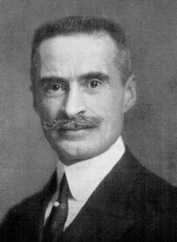Silvio Crespi: Difference between revisions
Iridescent (talk | contribs) m →top: Typo fixing, typo(s) fixed: , → , (2) using AWB |
No edit summary |
||
| Line 1: | Line 1: | ||
[[File:Silvio Crespi.gif|thumb|Silvio Crespi]] |
|||
[[File:Crespi panorama.jpg|thumb|Silvio Crespi played a major role in completing the [[model village]] and company town of Crespi d'Adda, today a UNESCO site]] |
[[File:Crespi panorama.jpg|thumb|Silvio Crespi played a major role in completing the [[model village]] and company town of Crespi d'Adda, today a UNESCO site]] |
||
'''Silvio Benigno Crespi''' (Milan, September 24, 1868 - Cadorago, January 15, 1944) was an Italian entrepreneur, inventor and politician. Firstborn of [[Cristoforo Benigno Crespi]] and Pia Travelli. He succeeded his father in running the firm of [[Crespi d'Adda]], today a [[UNESCO World Heritage Site]] that is considered notable for being a 19th and 20th century [[company town]] which reflected enlightened industrialists' respect for their employees.<ref>UNESCO, Crespi d'Adda, http://whc.unesco.org/en/list/730</ref> |
'''Silvio Benigno Crespi''' (Milan, September 24, 1868 - Cadorago, January 15, 1944) was an Italian entrepreneur, inventor and politician. Firstborn of [[Cristoforo Benigno Crespi]] and Pia Travelli. He succeeded his father in running the firm of [[Crespi d'Adda]], today a [[UNESCO World Heritage Site]] that is considered notable for being a 19th and 20th century [[company town]] which reflected enlightened industrialists' respect for their employees.<ref>UNESCO, Crespi d'Adda, http://whc.unesco.org/en/list/730</ref> |
||
Revision as of 17:16, 15 October 2016


Silvio Benigno Crespi (Milan, September 24, 1868 - Cadorago, January 15, 1944) was an Italian entrepreneur, inventor and politician. Firstborn of Cristoforo Benigno Crespi and Pia Travelli. He succeeded his father in running the firm of Crespi d'Adda, today a UNESCO World Heritage Site that is considered notable for being a 19th and 20th century company town which reflected enlightened industrialists' respect for their employees.[1]
He graduated with a law degree at age 21 and went to France, Germany and England to follow the development of the cotton industry. He also worked in Oldham, at Platt Brothers, a famous manufacturer of textile machinery. In 1889 he joined his father's firm Crespi d'Adda where he expanded the village and introduced the construction of homes with gardens.[2]
He was among the world's most powerful men at the time and signed the Treaty of Versailles at the end of the First World War on behalf of Italy.[3]
At the Second World Motor Transport Congress in Roma 25-29 September 1928, Silvio Crespi proposed to use containers for road and railway transport systems as collaboration not as a competition between road and rail systems under auspices of the international organ similar to the Sleeping Car Company for international carriage of passengers in sleeping wagons. He is a forgotten promoter of exploitation the container system in Europe before Second World War. [4]
References
- ^ UNESCO, Crespi d'Adda, http://whc.unesco.org/en/list/730
- ^ UNESCO, Crespi d'Adda, http://whc.unesco.org/en/list/730
- ^ WHAT IS CRESPI D'ADDA? at www.villaggiocrespi.it
- ^ Lewandowski, Krzysztof (2014). "Czechoslovak activity to prepare European norms for containers before the Second World War" (PDF). Acta Logistica. 1 (4): 1–7. ISSN 1339-5629.
